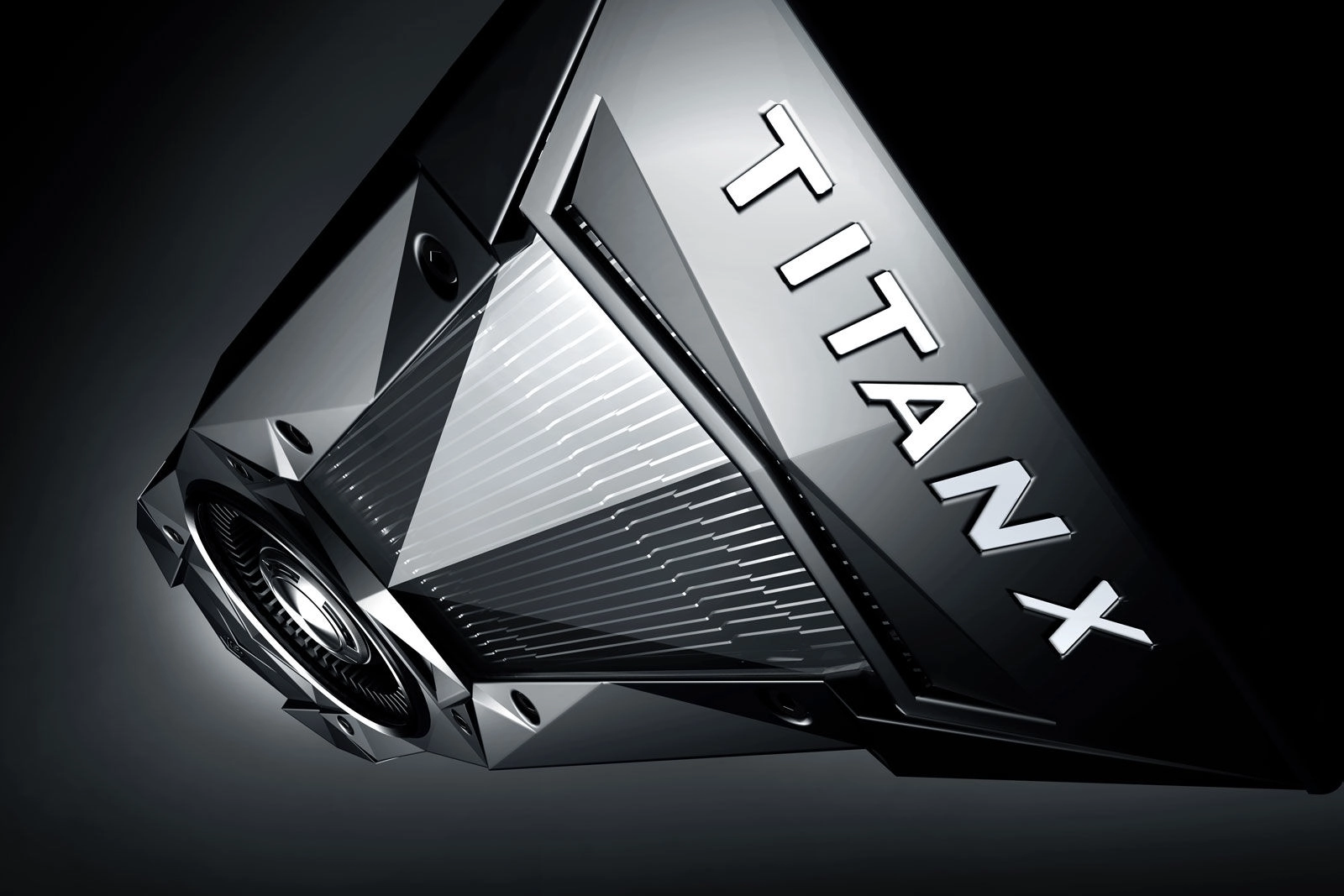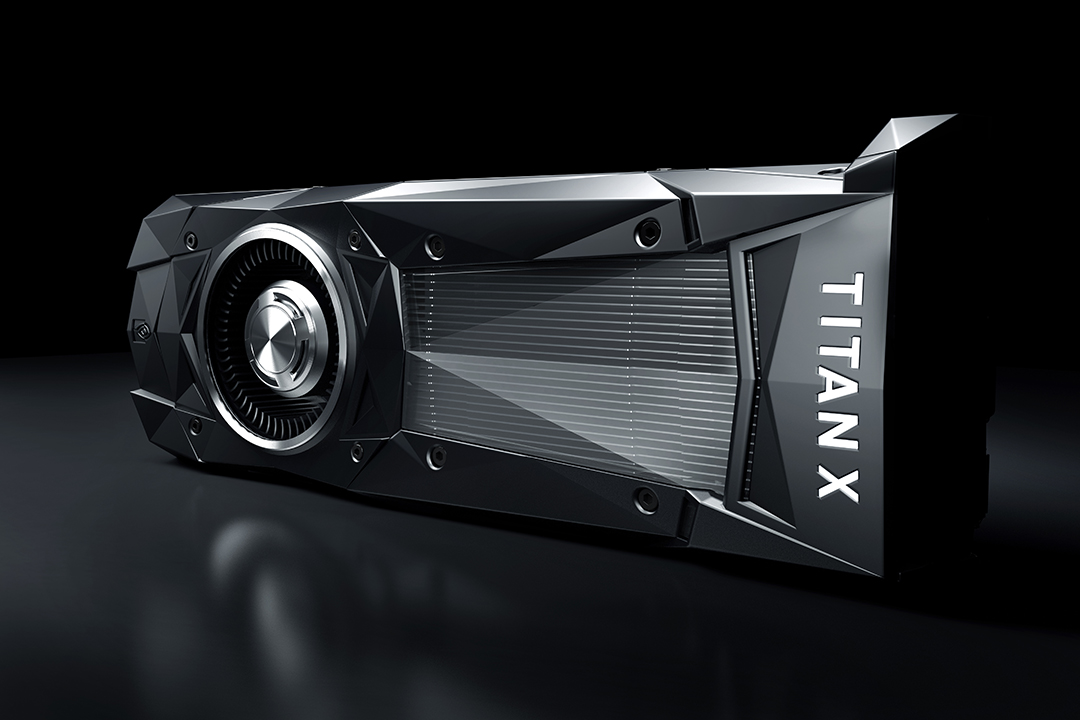
GeForce GTX TITAN X
NVIDIA just announced their new GeForce GTX TITAN X Video Card based on the Pascal GPU architecture. It is said to be the biggest GPU ever built and touts a record-breaking 3,583 CUDA cores. The card is said to be aimed towards artificial intelligence field, professional content creation, and gamers with ridiculous computer rigs. Using the vastly powerful GP102 graphics core, the TITAN X delivers 11 teraflops of floating point performance. The new Pascal-powered GPU consists of 12 billion transistors, 12GB of GDDR5X memory, and a memory bandwidth of 480 GB/s. On the clockspeed side, the TITAN X will be clocked at 1417MHz core and 1531MHz boost.

The GTX TITAN X is said to be built for anything and everything that resolves around graphically intensive applications. Using the GP102 GPU, the new TITAN X is made to perform best with PCI-Express based platforms and is a derivative of the GP100 GPU, which utilizes NVIDIA's NVLink technology.
Let's see how it compares to other Pascal-based models and it's predecessor:
| NVIDIA GPU Specification Comparison | ||||
| GTX TITAN X (Pascal) | GTX 1080 | GTX 1070 | GTX TITAN X (Maxwell) | |
| CUDA Cores | 3584 | 2560 | 1920 | 3072 |
| Core Clock | 1417MHz | 1607MHz | 1506MHz | 1000MHz |
| Boost Clock | 1531MHz | 1733MHz | 1683MHz | 1075MHz |
| TFLOPs (FMA) | 11 TFLOPs | 9 TFLOPs | 6.5 TFLOPs | 6.6 TFLOPs |
| Memory Clock | 10Gbps GDDR5X | 10Gbps GDDR5X | 8Gbps GDDR5 | 7Gbps GDDR5 |
| Memory Bus Width | 384-bit | 256-bit | 256-bit | 384-bit |
| VRAM | 12GB GDDR5X | 8GB GDDR5X | 8GB GDDR5 | 12GB GDDR5 |
| TDP | 250W | 180W | 150W | 250W |
| GPU | GP102 | GP104 | GP104 | GM200 |
| Transistor Count | 12B | 7.2B | 7.2B | 8B |
According to specs, NVIDIA's new TITAN X will deliver up to a 60% increased performance over its predecessor via additional cores and clock speeds. Compared to the recently released GTX 1080, the new TITAN X also promises up to 24% higher performance. Though the card is not shipping with the new High Bandwidth Memory 2, it does come with a generous 12GB GDDR5X memory allocation, a 50% increase over the GTX 1080- nothing to sneeze at. More power for less power, these performance upgrades are delivered via one 8-pin and one 6-pin power PCIe connector at a max TDP of 250W, same as the previous TITAN X.
The Pascal-powered TITAN X will support all the same technologies that the rest of the Pascal GPUs share, including support for NVIDIA Ansel, asynchronous compute, and simultaneous multi-projection. 2-way SLI will also be supported by the new TITAN card, however some users may be disappointed to know that 3-way and 4-way SLI configurations will no longer be supported.

The NVIDIA TITAN X is set for an August 2nd North America and Europe release. Exxact plans on integrating the new GPU in workstations and servers for computational research fields once the card is released. Learn how to preorder our TITAN X solutions here.

Let's Compare The Newly Announced NVIDIA TITAN X GPU
GeForce GTX TITAN X
NVIDIA just announced their new GeForce GTX TITAN X Video Card based on the Pascal GPU architecture. It is said to be the biggest GPU ever built and touts a record-breaking 3,583 CUDA cores. The card is said to be aimed towards artificial intelligence field, professional content creation, and gamers with ridiculous computer rigs. Using the vastly powerful GP102 graphics core, the TITAN X delivers 11 teraflops of floating point performance. The new Pascal-powered GPU consists of 12 billion transistors, 12GB of GDDR5X memory, and a memory bandwidth of 480 GB/s. On the clockspeed side, the TITAN X will be clocked at 1417MHz core and 1531MHz boost.

The GTX TITAN X is said to be built for anything and everything that resolves around graphically intensive applications. Using the GP102 GPU, the new TITAN X is made to perform best with PCI-Express based platforms and is a derivative of the GP100 GPU, which utilizes NVIDIA's NVLink technology.
Let's see how it compares to other Pascal-based models and it's predecessor:
| NVIDIA GPU Specification Comparison | ||||
| GTX TITAN X (Pascal) | GTX 1080 | GTX 1070 | GTX TITAN X (Maxwell) | |
| CUDA Cores | 3584 | 2560 | 1920 | 3072 |
| Core Clock | 1417MHz | 1607MHz | 1506MHz | 1000MHz |
| Boost Clock | 1531MHz | 1733MHz | 1683MHz | 1075MHz |
| TFLOPs (FMA) | 11 TFLOPs | 9 TFLOPs | 6.5 TFLOPs | 6.6 TFLOPs |
| Memory Clock | 10Gbps GDDR5X | 10Gbps GDDR5X | 8Gbps GDDR5 | 7Gbps GDDR5 |
| Memory Bus Width | 384-bit | 256-bit | 256-bit | 384-bit |
| VRAM | 12GB GDDR5X | 8GB GDDR5X | 8GB GDDR5 | 12GB GDDR5 |
| TDP | 250W | 180W | 150W | 250W |
| GPU | GP102 | GP104 | GP104 | GM200 |
| Transistor Count | 12B | 7.2B | 7.2B | 8B |
According to specs, NVIDIA's new TITAN X will deliver up to a 60% increased performance over its predecessor via additional cores and clock speeds. Compared to the recently released GTX 1080, the new TITAN X also promises up to 24% higher performance. Though the card is not shipping with the new High Bandwidth Memory 2, it does come with a generous 12GB GDDR5X memory allocation, a 50% increase over the GTX 1080- nothing to sneeze at. More power for less power, these performance upgrades are delivered via one 8-pin and one 6-pin power PCIe connector at a max TDP of 250W, same as the previous TITAN X.
The Pascal-powered TITAN X will support all the same technologies that the rest of the Pascal GPUs share, including support for NVIDIA Ansel, asynchronous compute, and simultaneous multi-projection. 2-way SLI will also be supported by the new TITAN card, however some users may be disappointed to know that 3-way and 4-way SLI configurations will no longer be supported.

The NVIDIA TITAN X is set for an August 2nd North America and Europe release. Exxact plans on integrating the new GPU in workstations and servers for computational research fields once the card is released. Learn how to preorder our TITAN X solutions here.




.jpg?format=webp)